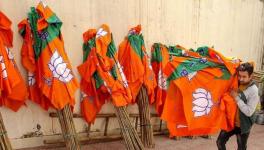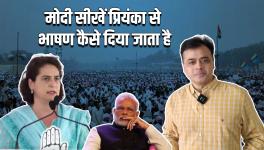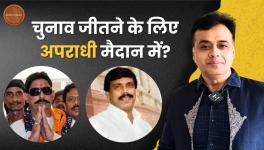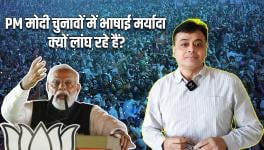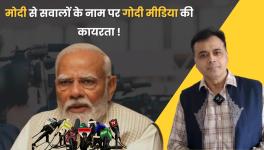Decade of BJP Rule: Plight of Marginalised Sections Has Worsened

Representational Image. Image Courtesy: Wikimedia Commons
As India is in turmoil with 18th parliamentary elections in process there is a great apprehension about the outcome of the same. The Bharatiya Janata Party (BJP), the ruling party, is claiming that it will get an overwhelming majority, beyond 400 seats, out of the total of 543. The coalition of Opposition parties, INDIA, led by the major opposition party, Congress, is stating that BJP cannot go beyond 150 to 180 seats.
The BJP is the electoral progeny of Rashtriya Swayamsevak Sangh (RSS), which was formed in 1925. Its formation and roots reveal a lot about its goals and agenda. That was the time when overcoming the shackles of colonial impositions the Indian masses, led by Mahatma Gandhi, unleashed protests against British rule.
That was the time when the Dalits (downtrodden, lowest in the caste hierarchy) were protesting against landlord-clergy (Brahmin) combine. Due to the threat posed to their social-economic political hegemony, many elites came together to form RSS in 1925. Their goal was Hindu Rashtra in contrast to the National movement, which was for secular-democratic nation. In due course, it floated many organisations; one was Bharatiya Jansangh formed in (1951). The BJP is its reincarnation, formed in 1980.
The RSS has twin foundations. One, to regard Muslims and Christians as belonging to ‘foreign religions’ and two, to revive the ‘golden past’ of the times when caste, class and gender hierarchy was based on birth. Today, the major part of its agenda seems to be directed against Muslims and Christians. As such, it has been totally suppressing the Dalits, other backward classes (OBCs), indigenous people and women.
It has a twin-track approach toward these sections of society. On the one hand, BJP’s gross policies are to the detriment of these sections and, on the other, they have floated few organisations to co-opt these very sections of society.
As far Muslims are concerned, they are 14.2% of the total population of India, as per the last census held in 2011. Their oppression is very visible, despite Prime Minister Narendra Modi’s proclaimed motto of ‘Sabka Saath, Sabka Vikas, Sabka Vishwas’ (taking along everybody, development for all and trust of all). They have also floated Rashtriya Muslim Manch (National Platform for Muslims), with the aim of winning over a section of Muslims, particularly Shias, Pasmandas and Sufis’ sects.
Despite this projection, one observes that in the current Parliament, where BJP has 395 MPs (both Houses) not a single one is a Muslim. Out of 57 members of Modi’s ministry, there is no Muslim. As far as atrocities against Muslims are concerned, during the past 10 years, the major violence against Muslims was in Delhi in 2019. This was in the aftermath of the protest against the new Citizenship Amendment Act (CAA), which did not include Muslims among those who were to be given citizenship. As per Human Rights Watch, 53 persons were killed out of which 38 were Muslims.
Overall, the targeting of Muslims on the issue of beef-cow has been harrowing. Beginning from the lynching of Akhlaq in Dadri to Junaid in a train, there have been nearly 100 cases of lynching. As per Business Standard newspaper: “As many of 97% of these attacks were reported after Prime Minister Narendra Modi’s government came to power in May 2014, and about half the cow-related violence–32 of 63 cases–were from states governed by the Bharatiya Janata Party (BJP) when the attacks were reported, revealed our analysis of violence recorded until June 25, 2017.”
“Love Jihad”, inter-faith marriage where the girl is a Hindu, has been another pretext of violence against Muslim youth. There are multiple issues through which Muslims are targeted, as the Human Rights Watch aptly points out: “Authorities in India have adopted laws and policies that systematically discriminate against Muslims and stigmatize critics of the government. Prejudices embedded in the government of the ruling Hindu nationalist Bharatiya Janata Party (BJP) have infiltrated independent institutions, such as the police and the courts, empowering (Hindu) nationalist groups to threaten, harass, and attack religious minorities with impunity.”
The economic plight of the community has seen a downturn. The last time there was a systematic evaluation of their economic status was in 2006, by the (Retd) Justice Rajinder Sachar Committee. The Sachar Committee pointed out: “Muslims face fairly high levels of poverty. Their conditions on the whole are only slightly better than those of SCs/STS, though slightly worse in urban areas. According to NSSO data, overall 22.7% of India’s population was poor in 2004-05 (251 million people), with SC/STs together as the worst off (at 35%), followed by Muslims at 31%.” And to cap it all, the increasing ghettoisation of the community is frightening, as most Muslim families are unable to get housing in the mixed localities. Things have worsened since then.
The Christian community is also under various hardships. The burning alive of Pastor Graham Steward Staines in 1999, was labeled as the “The killings belong to the world's inventory of black deeds” by the then President of India Dr. K.R. Narayanan. The most overt acts were noticeable in Kandhamal in Odisha. This was investigated by a Jury set up by National Peoples Tribunal, led by (Retired) Justice A P Shah. He remarked: “What happened in Kandhamal was a national shame, a complete defacement of humanity,” In this violence, nearly 100 Christians were killed and 300 churches were damaged.
The low-intensity anti-Christian violence has been going on in the remote places where prayer meetings are attacked on the pretext that missionaries are trying to convert. The Citizens for Justice and Peace tells us, “While incidents of violence have been recorded in 23 states, with June marking the highest number at 89, followed by July with 80, and other months contributing to this grim statistic, 13 districts in 3 states in India have emerged as dangerous zones for practicing Christianity.” According to Open Doors, India is 10th most dangerous place for Christians to live.
In the face of this, Modi is trying to woo some of the top clergy of the Christians. As per Indian Currents, “On December 25, Prime Minister Mr. Narendra Modi invited Christian representatives for an interaction and to greet them. He lauded the community for their social work and hailed the inclusive teachings of Lord Jesus Christ.”
To co-opt the down-trodden, BJP has floated various organisations like the Samajik Samrasta Manch (Social Harmony Forum), which try to win over Dalits through ‘seva’ (service) to the community. At policy level, they are trying to bypass affirmative action for deprived castes.
While the major opposition party, Indian National Congress, is calling for justice, more affirmative action, BJP, is not for reservations as a matter of policy. Wherever possible it does away with ‘reservations’ the major tool for uplift of the downtrodden in India. The economic plight of this section has worsened during the last 10 years in particular.
Sukhdeo Thorat, a prominent academic, states: “Dalits are employed in manual, unskilled labor jobs in urban areas. Given these facts, only 5% of the working Dalit population has actually benefited from the Indian reservation law… while GOI poverty alleviation programs help Dalits, the government does not strictly monitor them and many are never implemented…and the vast majority of Dalits are denied upward socioeconomic mobility due to lack of access to education, land, and capital.”
Their economic plight is harrowing. A report by UCANews points out this sense of being let down and it is expected that this rising anger among the community will get reflected in the 2024 Lok Sabha elections. By and by, this marginalised community is not taking the promises of BJP seriously.
This is the overall picture of the marginalised and downtrodden communities under BJP-Modi rule.
The writer is a human rights activist. The views are personal.
Get the latest reports & analysis with people's perspective on Protests, movements & deep analytical videos, discussions of the current affairs in your Telegram app. Subscribe to NewsClick's Telegram channel & get Real-Time updates on stories, as they get published on our website.














